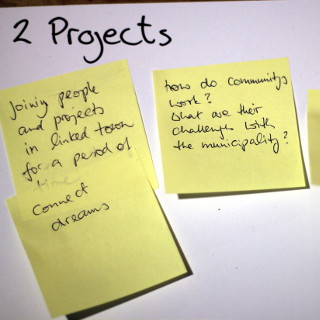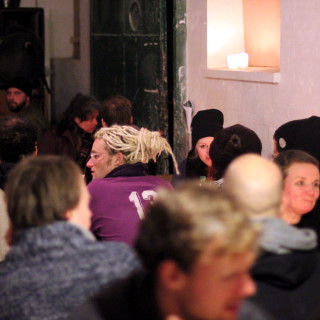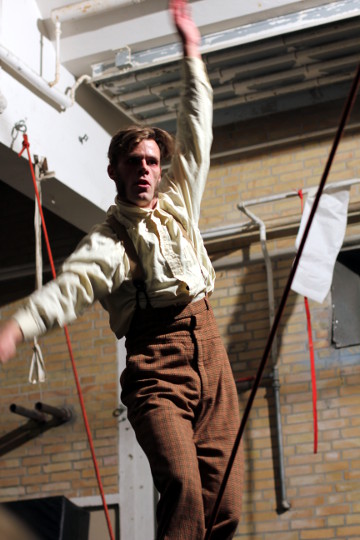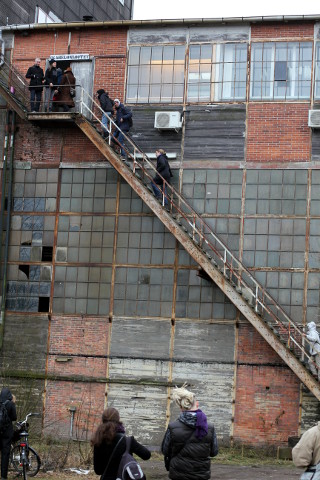City Link
Hamburg meets Copenhagen
by Ulrich Bildstein
Hamburg and Copenhagen are closing ranks; in 2021 Germany and Denmark will be joined by a tunnel. Creative pioneers are already discovering synergies and are devising a city of the future.
How do we want to live alongside each other? How do we utilise limited resources most efficiently? How are we going to deal with loneliness, isolation and social divides? How can we proceed into a good future?
We are thinking about such questions at the Oberhafen where a quarter for creativity is being newly developed. The Oberhafen e. V. is a group of people who are working at and for the Oberhafen. To us, the Oberhafen is to be more than just an industrial area for creative jobs; we want it to be a laboratory for research into new anwers to important questions of our time. We don’t want to develop a creative quarter; we want to creatively develop a quarter.
In the beginning ...
... there was a conference held by the University of Applied Sciences as part of the Interreg IVB project Creative City Challenge. In the summer of 2012, I met Jesper and Christian, who had been invited to Hamburg by the Department of Culture to develop cultural contacts between Hamburg and Copenhagen.

Many emails were sent to and fro that year until we succeeded in organising an exchange: a group from Copenhagen would visit Hamburg and creative people from Hamburg would visit Copenhagen.
This exchange was financed by the Departments of Culture in Hamburg and Copenhagen.
Willkommen in Hamburg
In addition to the Gängeviertel, Frappant and Centro Sociale, our visitors from Copenhagen also went to the Oberhafen – hotspots in Hamburg where user-defined city-planning is being tried and tested.

The assortment of participants from Copenhagen was as varied as the places we’d visited in Hamburg: artists, project initiators and city planners. The day of workshops in Oberhafen was extremely productive. Many nice people came up with very professional ideas and suggestions for the Oberhafen.
Velkommen til København
On a cold winter morning just before Christmas when everyone else was still asleep, the 35 participants met at the Gängeviertel ready for the second part of our exchange. Many came from the Gängeviertel, some from Frappant and a few from the Oberhafen. The bus journey was very wet, but the ferry trip was a welcome change; I didn’t see the need for a tunnel ...
After a heroically manoeuvred one-way system we arrived at approximately 1 o’clock at Prags Boulevard 43, a user-defined development project started by our hosts Jasper and Christian from Givrum.
We were greeted with a Silent Lunch. Wearing ear-protection increased the level of perception of the other senses enormously. Apart from being spared the small talk, the higher level of concentration was a wonderful experience. A bottle of Danish schnapps standing on the table served us well in breaking the ice between the hosts and guests.

Afterwards, we visited the old, privately owned industrial estate, which is being used for various projects of PB43 at present. For example, there is a carpenter’s workshop, a private university, rehearsal rooms and a cafe. The individual projects work independently of each other, but manage the complex together. PB43 shows his guests the wide variety of projects; his enthusiasm for community spirit is infectious.
During the afternoon, the participants discussed city development projects, ways of getting involved in their own neighbourhoods, artistic interventions in public places and political strategies.

After the launch of the Website City Link ideas for the further continuation of the project began to take shape. Speakers from Copenhagen presented projects which we were to visit the following day. A delicious evening meal, after which we could hardly move, a circus performance, further discussions, relaxing in the sauna and rice pudding at midnight brought the day to a wonderful close.
We slept in 4 bed dorms; thank God I had my earplugs with me. Before we fell asleep, some of the people from the Gängeviertel told of how much the project drains health resources and how difficult it is to secure enough finances to get the project off the ground.
Second day

After eating breakfast, slightly hungover, we went to Refshaleøen, e a huge area where a disused dockyard is being turned into artistic spaces. As a theatrical person myself, the theatre project impressed me most of all. Due to its organisation it is so much more flexible than the conventional theatre structures we are so familiar with. We had lunch at Madeleines where innovative preparation and presentation of food is combined to give a new artistic note, which calls the food industry’s dealings with foodstuffs into question.
The next stop was KPH, a creative area supported by the city, which offers young start-up firms space to get their businesses off the ground. Although the project follows a more traditional approach, it was impressive due to its inspired users.
The official part of our visit ended at Bolsjefabrikken, a left-wing housing project, successful in resisting monopolisation.
The very last stop on our tour was a detour to the mother of alternative city planning – Christiania. We arrived back in Hamburg at about 1.30am.
Lessons learned
On comparing points of view and differing life situations it became clear that though the globalised world creates similar problems in both Copenhagen and Hamburg, the ways of solving those problems differ considerably.
The separation of artists and the rest of the world, of administration and citizens so prevalent in Germany is slowly disappearing in Denmark, being replaced by a cooperative cooperation.
This difference was a recurring topic during our discussions and the question was asked as to how productive defining boundaries and points of view really is, opposed to the round-table approach.
Selectively formulated lines of argument produce palpable resistance, which helps to form clearly articulated demands for an alternative future.
Aggressive political viewpoints are often full of clichés and are less orientated towards finding practical solutions to problems, but more towards social conflicts.
Consensus-orientated discussions make understanding and movement possible, but also carry the risk that potential differing opinions be swept under the carpet.
Perhaps the most important hallmark of this trip was not just the excursion on which we looked at buildings and viewed planning processes, but it was also a journey to positioning ourselves politically, which was felt all the more strongly for being reflected in foreign cultures.
The informal character of this cultural exchange helped us make contacts on a personal level. Complicated strategic considerations about cultural exchange between Hamburg and Copenhagen are probably unnecessary. Personal contacts are the driving force in cooperation between the two metropoles on water.
We at Oberhafen are working on a city of tomorrow, on new ideas for the City Link and on projects for the Oberhafen as a partner for international exchanges.
City Link was made possible by the work of Christian und Jesper, and also by Ruth Bäßler who laid the foundations and provided the financial support for this project. Thank you.
We thank Rebecca Lenton for her accurate translation of this text into English.